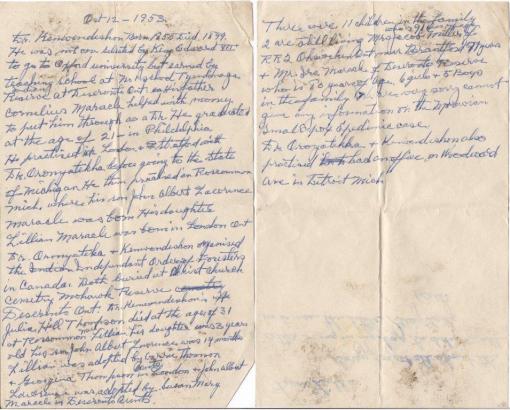One of the most prominent Mohawks associated with Deseronto was Dr Oronhyatekha (1841-1907), originally from the Six Nations Reserve near Brantford. He studied at the University of Oxford for a while and trained to become a doctor at the University of Toronto in 1867. He became involved in the Independent Order of Foresters and successfully transformed the finances of the organization. Oronhyatekha married Ellen Hill, a Mohawk from Tyendinaga Reserve. They had a house in Tyendinaga and the doctor also built properties on Foresters’ Island, which is situated in the Bay of Quinte, opposite Deseronto. These included ‘The Wigwam’, his elaborate summer residence; a hotel, and pleasure grounds. The postcard below shows the orphanage on the Island which Oronhyatekha constructed for the Foresters’ Order, and which operated from 1906 to 1907.

Imperial Order of Foresters’ orphanage
[Postcard loaned for scanning by R.N. Goodfellow]
Oronhyatekha’s fame overshadows history’s awareness of his Mohawk colleague, Kenwendeshon, who was born in Tyendinaga on April 8th, 1855, the son of Cornelius Maracle and Nancy Hill (a great-granddaughter of Deserontoyon). We have recently been in contact with a descendant of Kenwendeshon, who has been gathering information about his ancestor from a variety of sources, including the Kanhiote Library and the Legacy Center of Drexel University College of Medicine. He has kindly agreed to let us share the information he has obtained, to allow us cast some more light on this man, the first of the Mohawks of the Bay of Quinte to graduate from a university.
Kenwendeshon (also known as John C. Maracle) trained as a physician at the Eclectic Medical College of Pennsylvania and American University of Philadelphia (which has an intriguing history of its own), graduating in 1878. One of the items in the possession of Kenwendeshon’s descendant is a 1953 letter from the London Public Library which refers to a diary entry about an incident in 1874, when Kenwendeshon helped to turn the tide of a smallpox epidemic at the Moravian Indian mission at Fairfield (Moraviantown). The date is interesting, as he would only have been 18 at the time, and presumably unqualified: perhaps his association with Oronhyatekha began before he went to Philadelphia. Oronhyatekha had moved from Tyendinaga to London to begin a new practice in 1874, so may well have met the Maracles when he had been working in this area.
UPDATE, 25 May: Professor Michelle A. Hamilton of the University of Western Ontario has informed us that the epidemic was actually in 1879 and that Kenwendeshon left his practice in Syracuse, New York when Oronhyatekha asked for his assistance. Professor Hamilton also provided us with links to a file of digitized correspondence with the Indian Branch of the Department of the Interior held at Library and Archives Canada which details the response to the epidemic. Here is an example of the correspondence: a request from the Chief of the Moravian Indians to allow Dr Oronhyatekha to establish a temporary hospital “to isolate our small pox cases we have had four deaths six other cases local physicians refuse to come on the reserve”.

Telegram from Chief Stonefish, 21 May, 1879
A report from Oronhyatekha in this correspondence explains the circumstances of Kenwendeshon’s appointment:
…I have also employed a young physician who was formerly a student in my office & who himself has had the small pox to proceed to the reserve and be in constant attendance and to personally supervise the disinfecting of the clothing and houses of those Indians who have had the small pox.
[Professor Hamilton is currently co-writing a biography of Dr. Oronhyatekha with Keith Jamieson. This is going to be published by Dundurn Press in 2014.]
On November 20th, 1879 Kenwendeshon married Julia Hill Thompson in London and the couple had two children: Lillian, born in London in November 1880, and John Albert (Bert), born in Roscommon, Michigan, in August 1882. A note written in 1953 by Bert (reproduced below), suggests that Kenwendeshon worked with Oronhyatekha in London and Stratford before moving to Roscommon.

Note by Bert Maracle about Dr. Kenwendeshon
According to this note, Julia died in Roscommon when Bert was 14 months old (late 1884). We have not been able to track down a death record for her, but the two children were subsequently adopted into two different families, 400 kilometers apart. Lillian went to live with her mother’s two unmarried older sisters, Caroline and Georgina, and her grandmother, Henrietta Thompson, who lived in Queen’s Avenue, London, Ontario. Her brother, Bert, went back to Tyendinaga to live with his aunt, Susan in the household of his grandfather, Cornelius.
Kenwendeshon appears to have continued to working as a doctor in Michigan: in Roscommon and, later, in Beaverton. He died in Beaverton on September 22, 1899 at the age of 44 and was buried at Christ Church in Tyendinaga. His mentor, Oronhyatekha, died eight years later.
 Marlene Brant Castellano got our summer series of local history talks off to a great start with her examination of the local history of the Bay of Quinte from a Mohawk perspective.
Marlene Brant Castellano got our summer series of local history talks off to a great start with her examination of the local history of the Bay of Quinte from a Mohawk perspective.












